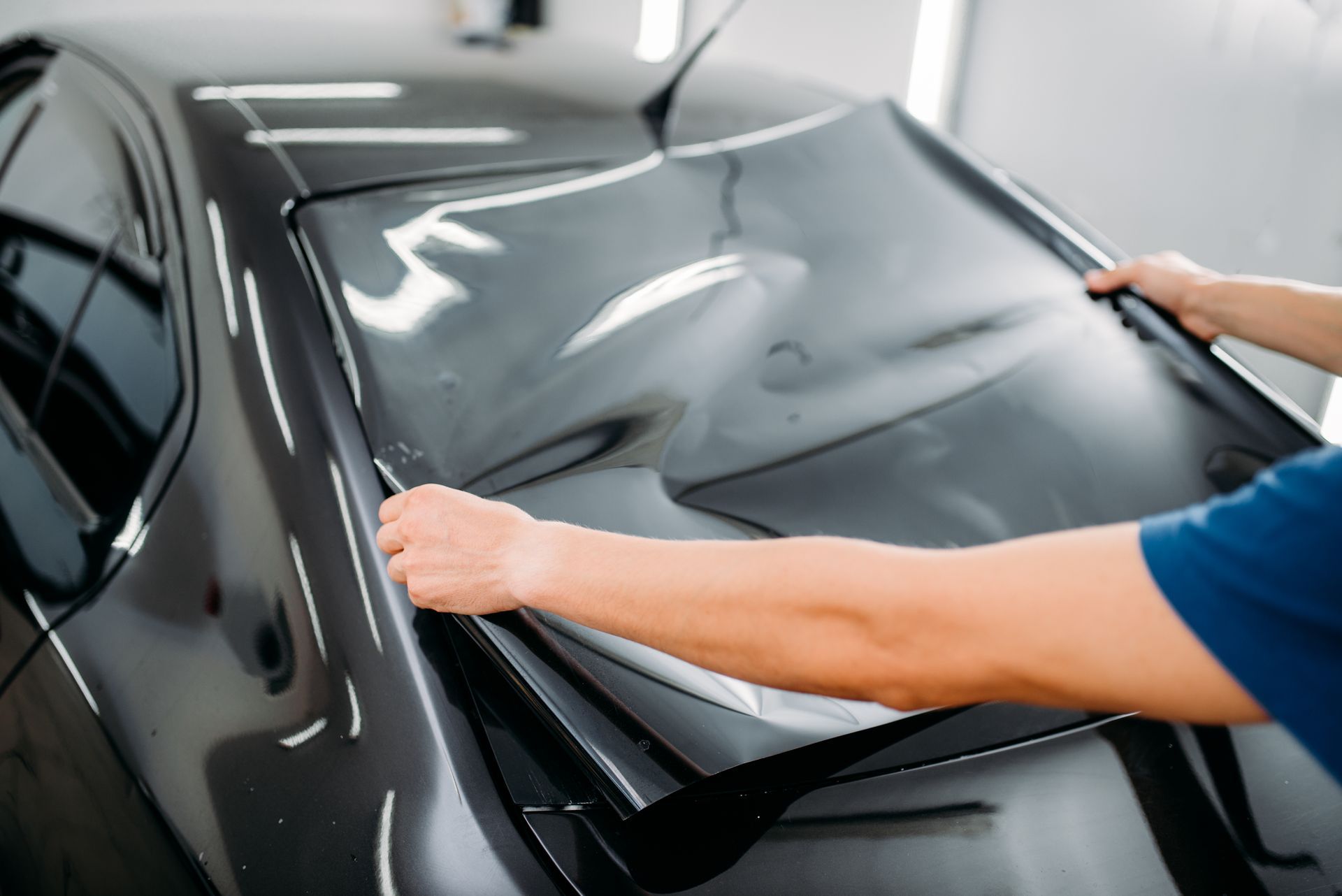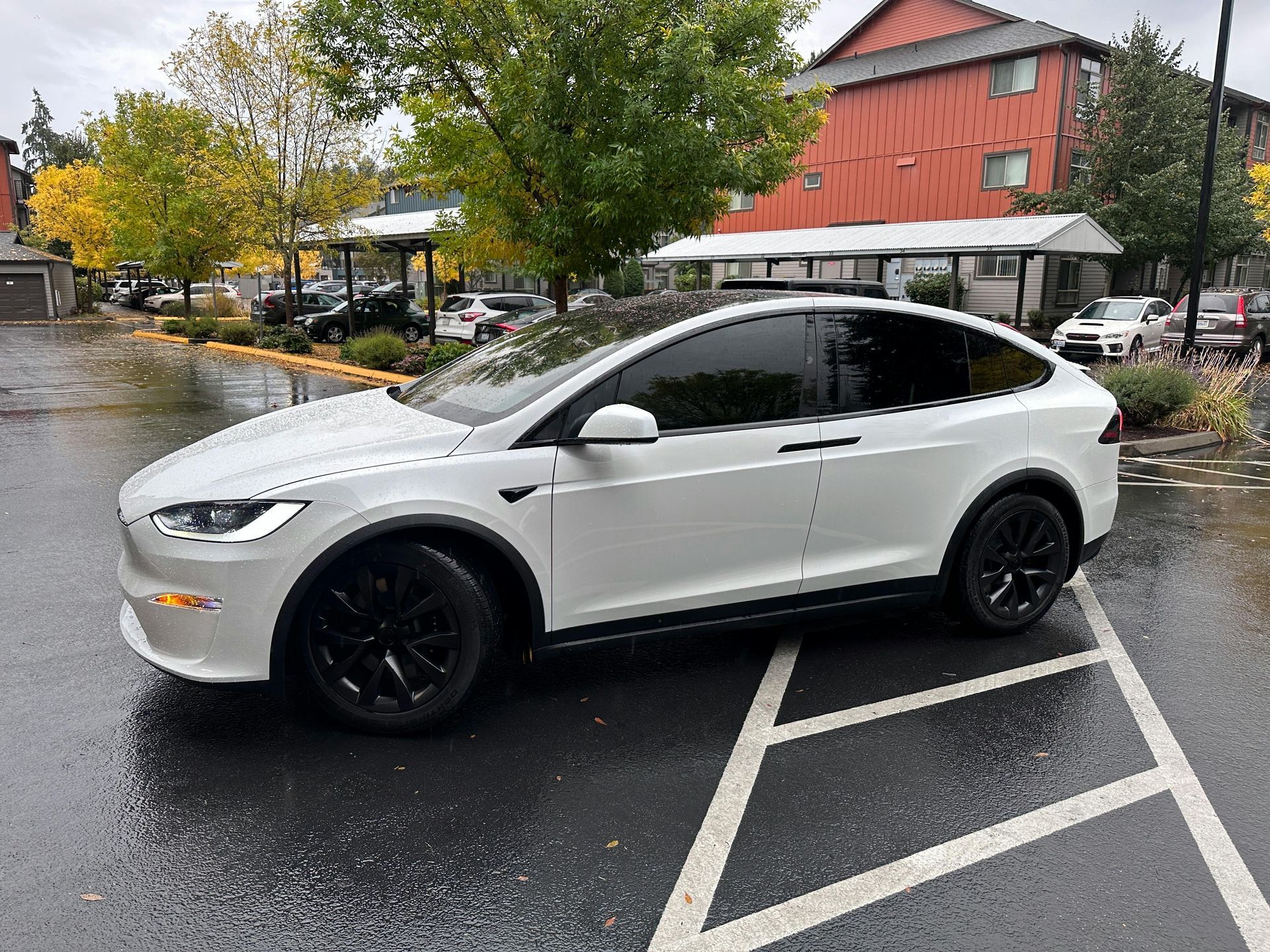Auto Window Film Heat Reduction: The Science Behind Heat Rejection
Summer drives can quickly become unbearable as dashboard temperatures soar past 150 °F. Heat rejection window film offers an effective solution, using advanced technology to transform the sun's invisible assault into manageable warmth while keeping vehicle cabins significantly cooler without compromising visibility.
Auto window film heat reduction specifically targets the sun's energy spectrum, where infrared rays carry approximately half the total heat load. Factory automotive glass allows nearly all solar energy to pass through, causing interior temperatures to spike 40 °F or more above outside air. Window films intervene by strategically reflecting, absorbing, or blocking this energy before it enters your vehicle.
Key Takeaways
- Solar energy divides into UV, visible light, and infrared radiation, with IR responsible for most heat buildup.
- Window films block heat through reflection and absorption, reducing total solar energy by 40–70%.
- Infrared rejection (IRR) measures a film's ability to stop heat-carrying rays.
- Ceramic films excel at heat rejection without signal interference, blocking 50-80% of IR.
- Total Solar Energy Rejected (TSER) gauges overall performance, with higher percentages meaning better cooling.
- Professional installation reduces AC usage by 10-15% and extends interior component life.
Understanding Solar Radiation and Heat in Vehicles
Solar radiation comprises three distinct segments that interact differently with automotive glass and interior surfaces.
The solar energy spectrum breaks down as follows:
- Ultraviolet rays (5% of solar energy):
These invisible rays cause fabric fading, dashboard cracking, and skin damage during extended driving. Although UV rays are only a small percentage, blocking them is beneficial for vehicle interiors and occupant health.
- Visible light (45% of solar energy):
This portion enables vision but contributes to glare and heat gain. Legal restrictions typically require maintaining at least 70% visible light transmission (VLT) through the front windows.
- Infrared radiation (50% of solar energy):
IR carries the primary heat load and warms surfaces invisibly. This energy penetrates standard automotive glass freely, causing intense heat buildup that makes parked cars feel like ovens.
Standard untinted automotive glass transmits 60-70% of total solar energy. Inside vehicles, heat accumulates through conduction from hot glass, radiation from heated dashboards, and trapped air. Without intervention, interior temperatures reach 140 °F on 90 °F days.
The science of infrared heat rejection focuses on wavelengths above 700 nanometers (nm), where thermal energy concentrates. Basic automotive glass absorbs some UV but allows IR to pass almost freely. Studies show vehicles lose 30% efficiency from excessive air conditioning demands. Auto window film heat reduction counters this by stabilizing interior temperatures.
How Do Window Films Block Heat?
How exactly do window films block heat? They manipulate three fundamental processes: reflection, absorption, and transmission. Each process is tuned to minimize interior heat gain while preserving visibility.
- Reflection bounces solar rays away before they penetrate glass, like a mirror for IR wavelengths. Metallic films are excellent at reflection, redirecting 30–50% of incoming solar energy. These films are highly effective, but they can interfere with radio, GPS, and cellular signals.
- Absorption captures solar energy within the film, converting it to low-level heat that dissipates mostly outward. Dyed films rely on this mechanism, darkening to absorb light energy. However, excessive absorption can warm the glass itself, conducting heat inward.
- Transmission control minimizes unwanted solar energy passing through to the vehicle cabin. High-performance films achieve total solar energy transmission below 40%.
The physics involves sophisticated nano-engineered layers. Rayleigh scattering within microscopic structures diffuses infrared radiation, while selective coatings target specific wavelength bands. Films bond to glass using optical-grade adhesives, ensuring even coverage without bubbles.
Parked vehicles with quality films remain 15–25°F cooler than those with factory glass. Therefore, does tint keep your car cooler? Absolutely. By slowing heat buildup from the moment you park, films reduce the thermal load your air conditioning must overcome.
The Science of Infrared Heat Rejection
Infrared radiation drives vehicle heating despite being invisible. The science of infrared heat rejection centers on blocking wavelengths between 780 and 2,500 nm, where most solar thermal energy is concentrated.
Near-infrared (700–1,400 nm) dominates automotive solar heat gain and is approximately 53% of total solar energy. High-performance films employ specialized ceramic particles engineered to resonate at these frequencies, pushing infrared rays away through wave interference patterns.
At the quantum level, nanoscale particles vibrate at frequencies matching infrared wavelengths. These particles absorb IR energy and re-emit it primarily outward. Unlike visible light blockage, infrared rejection (IRR) occurs without color changes, allowing "clear" films to reject substantial heat while maintaining excellent visibility.
IRR metrics quantify blocking effectiveness. A film rated at 70% IRR prevents 70% of infrared energy from entering your vehicle. Engineers balance these mechanisms: excessive reflection creates glare, while too much absorption warms the film. Advanced multi-layer designs optimize the reflection–absorption split for maximum heat rejection.
Types of Auto Window Films for Heat Reduction
The window film market offers diverse technologies for auto window film heat reduction:
Film type comparison
| Film Type | Heat Rejection (TSER) | IR Block | Pros | Cons |
|---|---|---|---|---|
| Dyed | 30–40% | 20–30% | Affordable, privacy | Fades within 3–5 years |
| Metallic | 45–55% | 40–50% | Strong reflection, durable | Blocks signals |
| Carbon | 40–50% | 35–45% | No signal interference | Moderate performance |
| Ceramic | 50–70% | 50–80% | Superior clarity, longest life | Premium pricing |
Dyed films absorb solar energy across the visible spectrum, offering 30–40% TSER and good privacy but fade relatively quickly.
Metallic films incorporate reflective metal layers, achieving 45–55% heat rejection and excellent durability. However, they interfere with radio reception, GPS, and cellular signals.
Carbon films deliver 40-50% heat rejection without metallic signal interference while maintaining better color stability than dyed films.
Ceramic films represent state-of-the-art technology, embedding non-metallic ceramic oxide particles that achieve 60-80% infrared blocking. These avoid signal interference while providing superior UV protection and 10+ year service life versus 3–5 for dyed films.
The best tint for heat rejection typically involves ceramic technology, balancing optimal thermal performance with functionality. Factory-installed privacy glass achieves only 15-25% heat rejection. Is window film better than factory tint? Yes, aftermarket films offer significantly superior heat rejection, UV protection, and customizable performance.
Measuring Heat Rejection: Key Metrics
How much heat does window tint block? Quality films typically reject 40-70% of total solar energy, depending on technology.
Total Solar Energy Rejected (TSER) sums blocked ultraviolet, visible, and infrared energy. A 60% TSER film prevents 60% of total solar energy from entering your vehicle.
Solar Heat Gain Coefficient (SHGC) measures solar radiation entering as heat. Lower values indicate better performance—films with SHGC under 0.40 deliver excellent heat rejection.
Visible Light Transmission (VLT) indicates the light percentage passing through. Most jurisdictions require a minimum 70% VLT on front windows for visibility and safety.
IRR measures blocked infrared radiation—the primary heat carrier. Premium ceramic films achieve 70%+ IRR, translating to cooler cabin temperatures.
Research indicates high-TSER films reduce air conditioning energy consumption by 10-15%, with corresponding fuel economy improvements.
Does Ceramic Tint Reduce Heat? Performance Analysis
Does ceramic tint reduce heat? Yes, through nano-engineered particles that efficiently scatter infrared radiation without darkening associated with traditional films.
Compared to dyed films, ceramics reject twice the infrared energy while remaining cooler to the touch. Versus metallic alternatives, ceramic films provide comparable or superior heat rejection without signal interference, ideal for vehicles with extensive electronics.
The car tint with highest heat rejection features ceramic construction, with premium products blocking up to 80% of infrared radiation. Real-world testing demonstrates 15–25 °F interior temperature reductions on hot days, transforming unbearable cabins into comfortable spaces requiring minimal air conditioning.
The main drawback is pricing, as ceramic films cost 40–60% more than carbon alternatives. However, this premium proves worthwhile considering superior comfort, extended lifespan, and potential fuel savings in hot climates.
Benefits and Real-World Impact
Beyond specifications, heat rejection window films deliver tangible improvements:
- Enhanced comfort and safety: Reduced cabin heat decreases driver fatigue and improves concentration. Cooler interiors preserve dashboard plastics, leather upholstery, and electronic displays, extending functional lifespan and maintaining vehicle resale value.
- Fuel economy and environmental benefits: Properly filmed vehicles improve fuel efficiency by 3-5% in hot weather through decreased AC compressor load. These savings translate to lower emissions, aligning personal comfort with sustainability goals.
- Real-world performance: Owners report faster cabin cooldown after parking in the sun, dramatically reduced steering wheel and seat temperatures, and quieter cabins due to sound-dampening properties.
To maximize the benefits of these films, you need to have them professionally installed. Expert installers ensure complete edge-to-edge coverage, eliminate air bubbles, and properly shape film to curved automotive glass.
Frequently Asked Questions
How do window films block heat?
Window films block heat through three primary mechanisms: reflecting infrared radiation away from the vehicle, absorbing solar energy within the film material before it enters the cabin, and reducing overall energy transmission through the glass.
Advanced ceramic films optimize all three processes simultaneously, creating a thermal barrier that can reject 50-70% of total solar energy while maintaining visibility and clarity for safe driving.
What is the best tint for heat rejection?
Ceramic window films represent the best tint for heat rejection, utilizing nano-ceramic particles to block 50-80% of infrared radiation without signal interference or excessive darkening. These films outperform dyed, metallic, and carbon alternatives in heat rejection while offering superior durability and optical clarity.
When selecting ceramic film, verify that the TSER ratings exceed 50% and ensure VLT compliance with your local regulations for optimal performance.
Does ceramic tint reduce heat?
Yes, ceramic tint significantly reduces heat by targeting infrared wavelengths responsible for thermal buildup, typically lowering interior cabin temperatures by 15–25°F compared to untinted glass. The nano-ceramic particles scatter IR radiation while remaining non-conductive, avoiding the signal interference issues of metallic films.
Users report noticeably reduced AC strain, faster cabin cooling, and improved comfort during hot weather driving conditions.
How much heat does window tint block?
Quality automotive window tint blocks 40-70% of total solar energy, with specific performance depending on film technology: entry-level dyed films achieve 30–40% rejection, while premium ceramic products reach 60–70%.
The infrared rejection component specifically ranges from 20–30% for basic films to 70–80% for advanced ceramics. Real-world temperature reductions of 15–25 °F in parked vehicles demonstrate that this heat blocking translates to meaningful improvement in comfort.
Does tint keep your car cooler?
Window tint definitely keeps cars cooler by reducing the rate of solar heat accumulation, making air conditioning more efficient from the moment you start driving. Quality films can lower parked vehicle interior temperatures by 15-25°F and reduce the thermal load on climate control systems by 10-15%.
For maximum cooling effect, combine window film with windshield sun shades and crack windows slightly when parked to allow hot air escape.
Final Thoughts
Heat rejection window films are a scientifically sophisticated solution that transforms oppressive solar heat into manageable warmth through engineered reflection, absorption, and transmission control. From understanding the science of infrared heat rejection to selecting between ceramic, carbon, or metallic technologies, your informed choices deliver measurably cooler, safer, and more efficient driving experiences year-round.
Want to feel more comfortable inside your car? We can help.
Reference:
https://www.sciencedirect.com/topics/chemistry/rayleigh-scattering



